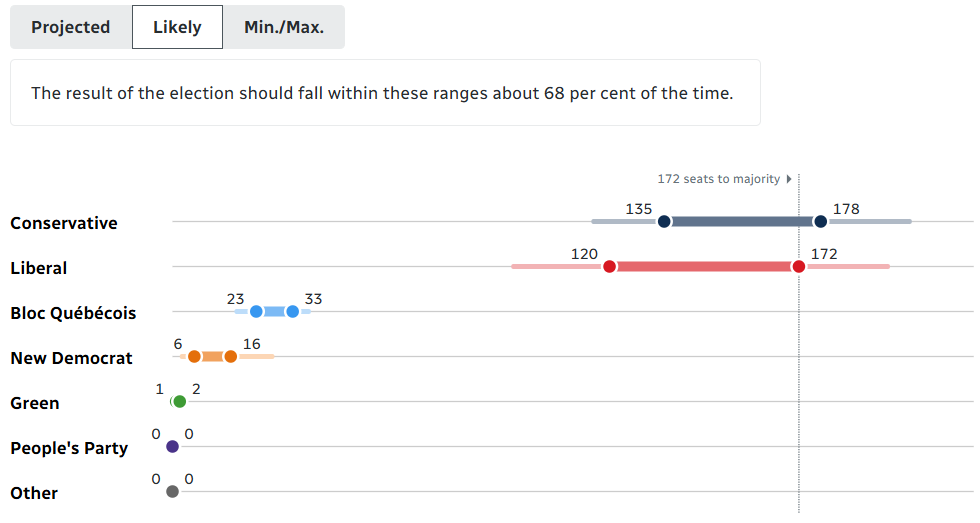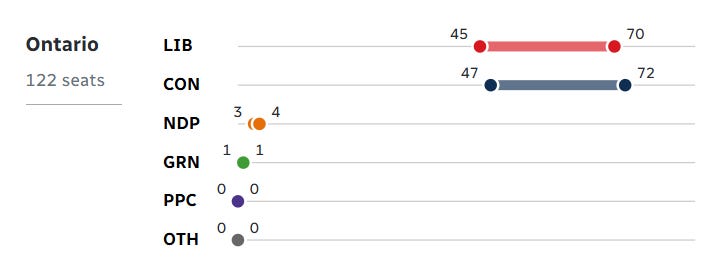Projection Update: It's (almost) a toss-up
The polls are nearing a neck-and-neck race.
The Liberals appear to have a little luck of the Irish.
Of course, everyone is a little Irish on St. Patrick’s Day, but Mark Carney is more than a little Irish. His family ancestry is from the Emerald Isle and he held, at least until very recently, Irish citizenship. (Your humble correspondent also traces a small portion of his, rather more distant, ancestry to Ireland.)
The Liberals’ meteoric comeback has an element of luck to it, as Donald Trump’s attacks on Canada has given the party a renewed lease on life. Carney’s experience and style, which might have seemed dull and uninspiring in any other context, appears instead to be what many Canadians are looking for to meet this moment — at least enough of them to make the next election a toss-up.
Today’s update to the Poll Tracker still gives the Conservatives the lead and has them in front in the seat projection, but their advantage on both counts keeps getting smaller and smaller. This is in part due to what the latest polls are showing, but it is also due to the number of new polls being added to the aggregate.
As I’ve pointed out a few times, the projection model behind the Poll Tracker is relatively patient outside of election campaigns. It is designed not to swing around too dramatically at a time when only a few polls are being published every week. For that reason, it is still showing a modest Conservative lead of 5.5 percentage points. But while a few new polls show the Liberals very narrowly ahead (Mainstreet Research and Liaison Strategies), other polls are still showing the Conservatives leading by a wider margin (four points according to Abacus Data, six points according to the Innovative Research Group).
I think it’s reasonable to take a more cautious approach in such a volatile environment. Older polls will age-out of the projection far more quickly once the campaign gets going. If the pace of decay was set at what it’ll be by the last two weeks of the campaign, the model would be showing a tie between the Liberals and the Conservatives in the poll average (and the Liberals on the cusp of a majority in the seat projection). But by the campaign’s end there will be many more polls in the field, making the aggregate more balanced than it would be now with the same aggressive date weighting. That late-campaign date weighting today would cause only two polls to occupy a majority of the weight in the model — hardly ideal. We won’t have the same problem when multiple polls are being published daily.
But this gives us an idea of where things appear to be headed. It’s already very close in the seat projection even with the 5.5-point Conservative lead. The Conservatives are now projected to win 159 seats against 142 for the Liberals, with likely ranges that overlap significantly.
The Bloc is projected to win 28 seats while the NDP is down to just 12, the threshold for official party status. If these were the results of the next election, the Conservatives could govern with the support of the Bloc, but would otherwise need to have backing from both the NDP and Greens to get anything passed. The Liberals would need the support of the Bloc and either the NDP or the Greens. This is not a parliament that would be destined to survive very long.
While the Liberals have made gains throughout the country, it’s Ontario that has changed things the most. The Conservative lead in the province is now projected to be only 3.9 points and it is a toss-up as to which party would win the most seats.
The Conservatives are projected to win between 47 and 72 seats in Ontario, with the Liberals winning between 45 and 70. Those are wide ranges because so many seats are projected to be decided by just a few points. But that also means that if, in the next update, the Liberals are up a handful of points in Ontario many seats will flip to them, and they will be projected as the favourite to win the election.
Programming note: As we’re now in waiting mode for the writ to drop, there will be no Weekly Writ this Wednesday. Instead, I’ll likely have another Projection Update at some point during the week, as well as new episodes of The Writ Podcast and The Numbers.
Battleground…Alberta?
The swathe of seats in the Greater Toronto Area will decide the election, as they normally do. But there are a few other places where some unexpectedly tight battles will be fought. Including Alberta.
Wait, what?





